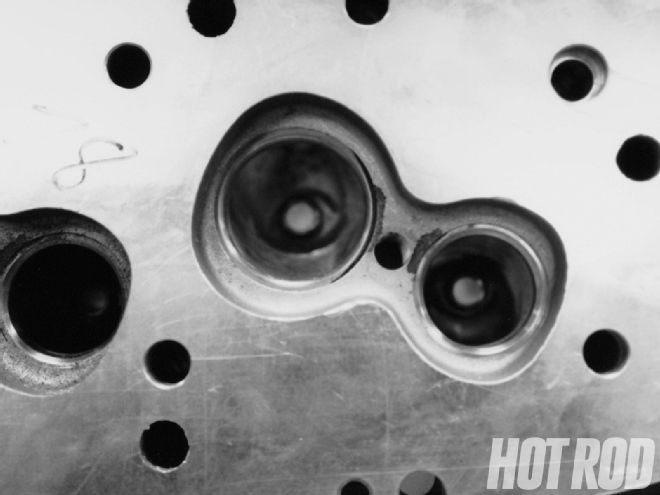
Big Street Cubes!
The technological advances applied to current passenger-car engines have produced levels of power and driveability that would have been unheard of just a few years ago. To a red-blooded American motor head, though, all the technology in the world cannot replace cubic inches. It has been proven that large-displacement engines are very good at producing huge amounts of inexpensive power. We wondered what would happen if the latest technology was applied to a 500ci "hot rod" motor.
 The patented Feuling curvilinear valve incorporates an extended margin to aid in low-lift airflow.
The patented Feuling curvilinear valve incorporates an extended margin to aid in low-lift airflow.
Our engine of choice was the Mark VI Chevrolet 502, the standard bearer of the GM Performance Parts catalog. We must caution you, though: This is going to be an engineering exercise and not a typical magazine-style engine buildup. We are not sure of the results going into this and are confident that we will encounter obstacles along the way.
We hope to reach our desired goal of 700 lb-ft of torque on 87-octane fuel while still being emissions-compliant and to also record historically low numbers for brake-specific fuel consumption (BSFC). Torque? Emissions? Fuel economy? Octane tolerance? Have we gone bonkers? Yup.
Anyone can make dirty, thirsty power on race gas. The essence of a performance car is the ability to drive it, a quality firmly entrenched by the success of the Power Tour. To qualify as a bona fide driver, pump gas is a must. In most parts of the country there is a 25- to 30-cent spread on the price between regular and premium gas, so it would be economically reasonable to run the cheap stuff. Low double-digit fuel-economy numbers would be the minimum we'd accept. With much tougher emissions standards looming, the threat of the EPA would be softened if we met these goals while keeping the air clean.
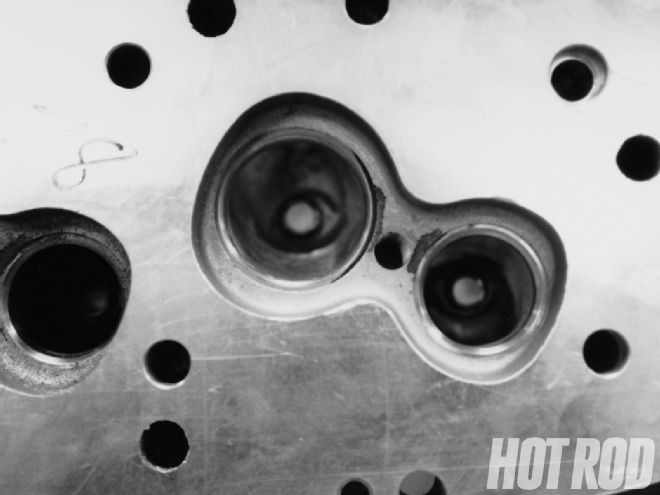 The uniqueness of the Feuling Center-Fire combustion chamber is quite apparent. Note the centrally located spark plug.
The uniqueness of the Feuling Center-Fire combustion chamber is quite apparent. Note the centrally located spark plug.
Most of us are used to horsepower. In almost every street application, you buy horsepower but drive torque. Remember that a dynamometer registers torque, which is simply how much work an engine can accomplish. Horsepower is mathematically derived from torque and is defined as how quickly that work can be accomplished. You need rpm for horsepower, but torque is the stuff that shoves you in the driver's seat and blows the tires away.
The Plan
Northwestern College in Lima, Ohio, provided the complete use of its shop facilities. As a class project, the student body would execute all aspects of the research and the engine buildup. Instructors Bill White, Bill Sergent, and Mike White assigned the challenge to their high-performance curriculum enrollment. The students were charged with meeting the goals of high specific torque production with increased thermal efficiency (BSFC) and increased octane tolerance, while simultaneously reducing emissions numbers.
These conflicting goals would require careful examination of each engine component within the realm of commercially available parts. This became especially difficult when applying our demands to a large-bore engine. Increases in bore sizes tend to exponentially increase emissions generation and a propensity toward abnormal combustion (detonation) due to the distance the flame must travel. Crevice volumes created by a piston of 4 1/2 inches, as our 502 possessed, would be prone to retaining hydrocarbon emissions and would add to the likelihood of detonation.
Conversely, high thermal efficiency would be needed to yield lower-than-current standards for BSFC on a big-block Chevy (BBC). High compression ratios are the easiest method to increase fuel economy-the downside is high NOx emissions and detonation. One point higher in compression yields a 2-percent increase in power and a reduction of 4 percent in fuel consumption. With these goals in mind, the selection of the cylinder head, camshaft profile, intake-manifold runner length, piston material, engine man-agement, and even the cooling system, is critical.
We divided the engine into two sections, thus creating a mechanical design team and an engine-management team. The mechanical group defined the cylinder-head selection, piston and ring design and material, target compression ratio, camshaft events, oiling and cooling system, and the selection of the intake manifold. The management side addressed ECU selection, Lambda feedback control, closed-loop timing control, primary switching location, and ignition-system output.
As an added obstacle, all of the components would have to be available to the populace, and we established an imaginary budget of $12,000 for the entire project. During the selection process, each team had to petition the entire group to justify an expenditure for a certain item. If the engine-management side wanted a $5,000 ECU, a disproportionate amount of the budget would need to be spent on it. This expenditure would then be approved by a majority vote. A convincing argument would be required in order to allow the expense. The groups also considered the practicality of the component and the ease of installing the engine in a vehicle. This process was instituted for the students as a real-life example that in industry, a product comes to market by compromise and by identifying the value added or diminished by the design criteria.
Decisions
The final engine design included a Mark VI block; GM crankshaft and connecting rods; Feuling R&D Center-Fire cylinder-head package and custom-ground hydraulic-roller camshaft; Keith Black Hypereutectic pistons with Sealed Power rings; ACCEL Stealth EFI manifold; spark/fuel ECU with wide-band linear feedback control; variable injector controller; 300+ ignition, wires, and roller-bearing distributor; a Moroso oil pan, oil pump, and filter; ATI harmonic crank damper; Edelbrock high-flow water pump; and Evans NPG coolant.
Cylinder Heads
The usual Chevy cylinder heads are limited to either oval- or rectangular-port configurations and opened or closed combustion chambers. Regardless of achievements in fuel and ignition management, the net effect on power generation and octane tolerance and engine-out emissions are, and always will be, limited to the efficiency of the combustion chamber.
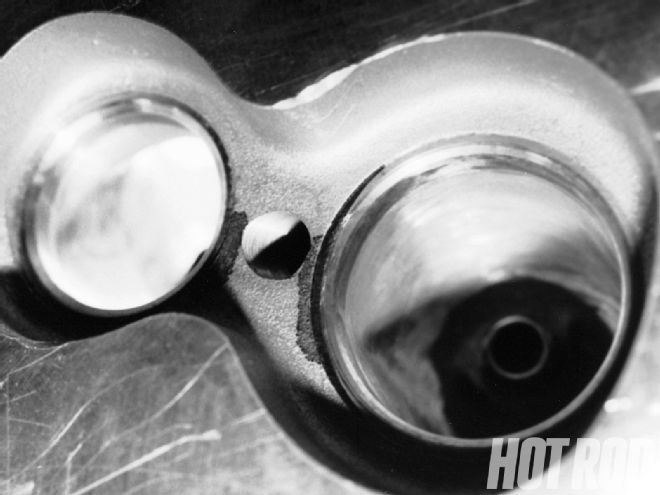 The purpose of the port work was to blend the bowls, which would remove the lip left by the machining process necessary to install the valve seats.
The purpose of the port work was to blend the bowls, which would remove the lip left by the machining process necessary to install the valve seats.
The combustion event determines the amount of cylinder pressure as a by-product of the expansion of the flame front. Cylinder pressure is what makes power, and airflow is a critical part of that equation. However, the efficiency of the combustion event, including burn rate, charge stratification, spark-plug location, and intake and exhaust velocities, is often overlooked. Impressive airflow numbers will yield impressive power only through an effective combustion sequence. With this in mind, take all you know about cylinder-head design and throw it away when discussing the Feuling Center-Fire cylinder head. Jim Feuling founded this technology on torque bias, high port velocities, quick burn rates, low heat transfer to the cooling system by minimizing exhaust-port area, excellent airflow to promote good volumetric efficiency, low emissions, decreased BSFC from current technology, increased octane tolerance, a centrally located spark plug, high compression with a flat-top piston for good thermal efficiency and low surface-to-volume ratios.
Developed as a systems approach, the patented Feuling design incorporates a 78cc combustion chamber that resembles a figure-eight with a centrally located spark plug. It also offers a very high squish-to-bore relationship-better than 55 percent on our 502. The large squish area, paralleled with a zero deck height and a 0.025-inch piston to deck clearance, produces a 12.3:1 compression ratio and effectively creates a high amount of internal charge acceleration. It is well established that any time mixture motion can be produced, the net effect is increased octane tolerance and quicker burn rates. Flame speeds vary in engine designs from approximately 10 to 25 meters per second. An open-chamber BBC would usually have a flame rate nearer to 10 meters per second, while the Feuling design offers speeds of 25 meters per second. Cylinder heads that utilize mixture motion usually rely on externally induced motion or swirl. This is evoked by the valve placement, the incorporation of a swirl dam in the bowl area, or shrouding of the intake valve in the combustion chamber-all of which help to homogenize the charge. The problem lies in the fact that it takes energy to swirl the incoming charge, which in turn compromises airflow capabilities. Excessive amounts of swirl have also been known to centrifuge the fuel to the extremities of the bore, creating rich and lean pockets while wetting down the cylinder wall. The Feuling approach incorporates no swirl with nearly vertical valve angles and large squish pads to induce internal charge acceleration. This accelerates the charge as the piston nears top dead center (TDC) but also stratifies it near the centrally located spark plug. By placing the spark plug in the middle of the bore, cylinder pressure is built sooner in the crankshaft's arc of rotation past TDC, producing more power from less fuel with increased octane tolerance.
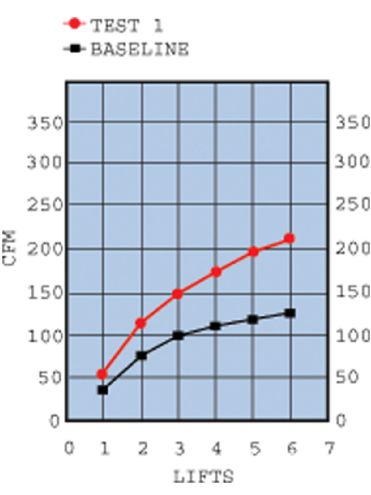 Intake and exhaust flow displayed graphic-ally as the heads were received.
Intake and exhaust flow displayed graphic-ally as the heads were received.
Vibrant port velocity was deemed critical, and the use of small 247cc intake ports and 58cc exhaust ports aid in that goal. The valves are limited to 1.850 inch and 1.435 inch for intake and exhaust, respectively. Commonly thought of as too small for even a 350ci motor, they are quite compatible with Feuling's special ports. The patented intake-valve design possesses an extended margin and a curvilinear concept. This creates substantial gains at low lift by providing laminar flow across the valve seat.
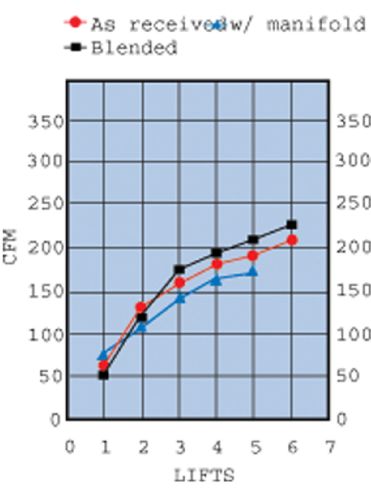 The bowl work showed gains of approximately 25 cfm. Note the flow restriction created by the 14 1/2-inch-long intake-manifold runners.
The bowl work showed gains of approximately 25 cfm. Note the flow restriction created by the 14 1/2-inch-long intake-manifold runners.
Normally, an extremely high compression ratio would equate to high rates of NOx emissions created by extreme cylinder pressures when exposed to leading-edge flame-front temperatures of 2,500 degrees F or greater. The Feuling combustion chamber cheats this phenomenon by limiting the amount of exposure time the gases have with its extremely quick burn rates.
Pistons
The mechanical-design team chose Keith Black flat-top hypereutectic pistons for their ability to reflect the heat from the combustion back into the event itself. This increases power and lowers fuel consumption and ignition-timing requirements. Offering nearly the strength of a forged piston with the limited expansion of a cast design, the hypereutetic pistons allow for a very tight fit. The students arrived at a 0.0025-inch piston-to-wall clearance, which is looser than normal but deemed necessary due to the severe duty our dyno mule would experience. Wrapped with Sealed Power file-fit rings, the unique KB piston necessitated a top gap of 0.040 inch and a second ring gap of 0.020 inch. There was some concern for cold-start emissions with the expanded ring gap producing excessive blow-by, but the minimal expansion characteristics of the piston, along with the student's inability to expose the engine to an actual EPA cold-start cycle, negated these concerns.
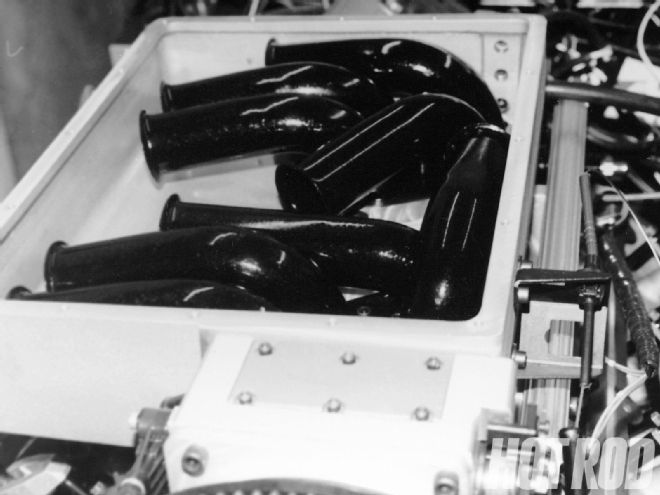 The runner extensions were dripping with fuel, indicating intake reversion, but to travel all the way up a 14 1/2-inch runner it would have to be serious.
The runner extensions were dripping with fuel, indicating intake reversion, but to travel all the way up a 14 1/2-inch runner it would have to be serious.
Intake Manifold And Camshaft Profile
The ACCEL Stealth BBC manifold offers more than 14 1/2 inches of tuned intake runner length and the advantage of producing superior torque production at the point of resonance over untuned designs, albeit at the expense of high rpm power. Since torque production was one of our primary goals, this was a desirable quality. When matched with a cam that opens the intake valve to coincide with the arrival of the second harmonic pulse, a greater inertial supercharging effect is derived from the tuning process. It is generally accepted that the second harmonic pulse is both the strongest and longest. The best use of this pulse is obtained if the intake valve is open 0.02 times the valve diameter by 15 degrees before TDC. A roller hydraulic cam, with ramps coinciding with this theory, was supplied by Feuling R&D (216/220-degrees duration at 0.050-inch lift on a 114-degree lobe-separation angle). Very minimal overlap was induced to limit hydrocarbon production.
Engine Management
ACCEL electronic controls were used throughout. The team employed a spark/fuel ECU with wide-band linear oxygen-sensor capabilities, along with a variable injector controller and 300+ digital ignition. An ACCEL-supplied Delco closed-loop timing-control kit was also used to identify detonation.
The linear oxygen-sensor function was chosen due to its use of a =1.5 oxygen sensor. (Most OE and aftermarket fuel-injection systems are only able to accurately identify an air/fuel ratio of 14.7:1 [stoichiometric]. The wide-band option allows for accurate targeting of mixtures that are richer or leaner than stoichiometric and was employed to aid in tuning, not for power production.)
A variable injector controller (VIC) allows the alteration of injector pulse width as a function against the programmed pulse table in the ECU. This corrects for any cylinder-to-cylinder distribution problems. The digital accuracy of an ACCEL 300+ CD ignition, along with the companion secondary wires and distributor, complete the system. A crank trigger was originally proposed due to its accuracy in identifying the cylinder events and allowing timing adjustments near the spark knock zone without any scatter. However, the complexity of interfacing this trigger point to the acces-sory drives in a vehicle installation was found to be impractical.
Cooling System
The heat-dissipation capability of the cooling system would be critical. Com-monly overlooked as a cause of abnormal combustion, the subject engine would be tested with a closed cooling system in lieu of the water tower customarily used with engine dynameters. The closed system would allow for pressurization and aid in the conversion from the nucleate boiling state back to a liquid. Cooling Systems Warehouse, the sole distributor of the Evans NPG coolant, supplied us with its waterless-based formula. Designed to withstand unpressurized nucleate boiling to 369 degrees F, and being able to move quickly away from the site due to an extremely low dymes/cm rating, it will aid in quenching detonation. The Evans NPG circulates via a high-flow Edelbrock water pump.
The Best Laid Plans...
The day of reckoning arrived. Calculator numbers would be replaced by the bald truth of a Super Flow 900 dyno. The team broke in the 502 for 30 minutes. Then they changed the oil and the Moroso filter.
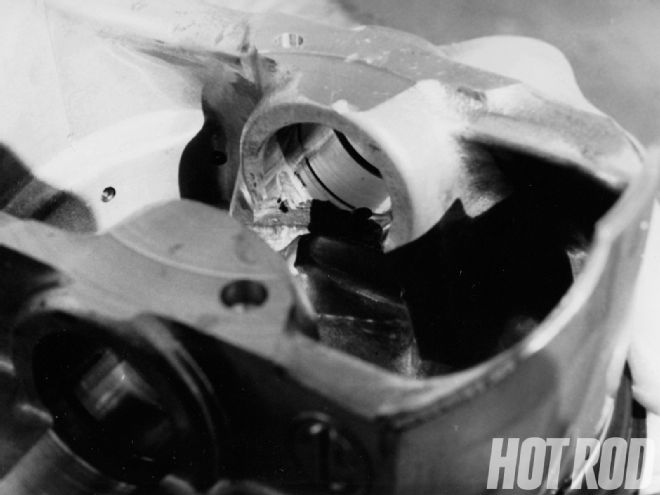 A broken pin bore allowed the wristpin to walk out and score the cylinder wall. Repairing it with a sleeve was the easy part, but what caused these problems?
A broken pin bore allowed the wristpin to walk out and score the cylinder wall. Repairing it with a sleeve was the easy part, but what caused these problems?
Exhaust-gas temperatures during break-in were the best the instructors had ever seen, substantiating an even distribution of fuel and air. Everything looked promising. A part-throttle pull pinned the load scale, indicating that the water brake could not hold the torque and required readjustment (the previous dyno occupant had been a 400lb-ft-injected small-block).
During run-in, the 502 idled smoothly, requiring only minimal work to the fuel and spark tables. Throttle response was instant, and the rpm climbed at an unheard of rate for such a large engine. Within a few minutes, though, the idle deteriorated. In an attempt to restore smoothness, the team trimmed the fuel map and idle-spark functions. Working under the assumption that they "dirtied-up" the motor, they made a short part-throttle pull to 3,000 rpm. The beast made nearly 500 lb-ft but did not sound happy. With the throttle closed, it idled poorly and stalled. Another short pull caused the 502 to balk, so the load was quickly removed. The valve lifters on the right side of the engine were beginning to clatter while the distinct clank of a loose rocker emanated from the left-side cylinder head. An exploratory revealed a loose polylok, so it was decided to readjust all of the valves.
The engine started, but stalled just as quickly, as if it had run out of fuel. Another try kept it running to the cacophony of 16 lifters that were bled down and did not want to pump back up. The lifters stayed noisy, and the idle was going away; meanwhile, the feedback from the linear oxygen sensor was not coinciding with the exhaust-gas data. A quick jab of the throttle revealed a substantial bog. The team trimmed the fuel map so that the engine would run long enough to allow them to see what was happening. The data was representative of fuel reversion or standoff, so they shut the motor down. Inspection through the throttle body revealed that the runner extensions were dripping with fuel.
Reversion? Why? Historically, a mismatch of the cam specs to the intake manifold would cause standoff, but to spit fuel back up a 14 1/2-inch-long runner was mind-boggling. Everyone involved agreed to make another 3,000-rpm pull, but just as the load was coming on, a connecting rod began knocking. Disassembly revealed a plenum with puddles of fuel and a broken pin bore on the number-two piston.
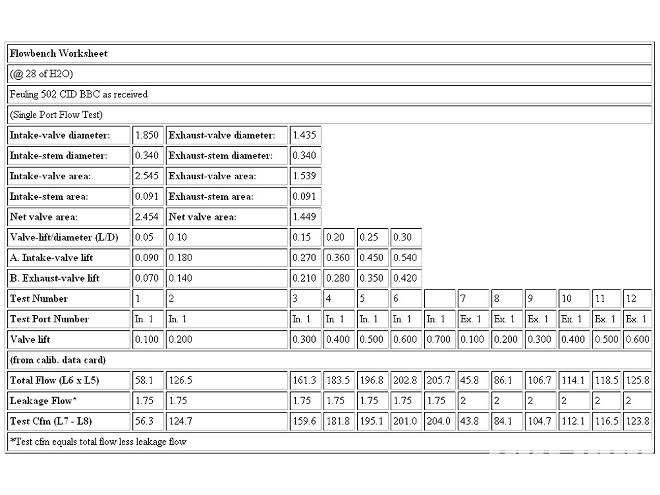
Were the lifters bleeding down at different rates and causing the reversion? What caused the pin bore to snap on the oil side? Did they hydraulic the motor with the reversion? Why would the lifters not pump up? We'll be back next month with the final segment of the Lima Freight Train saga.